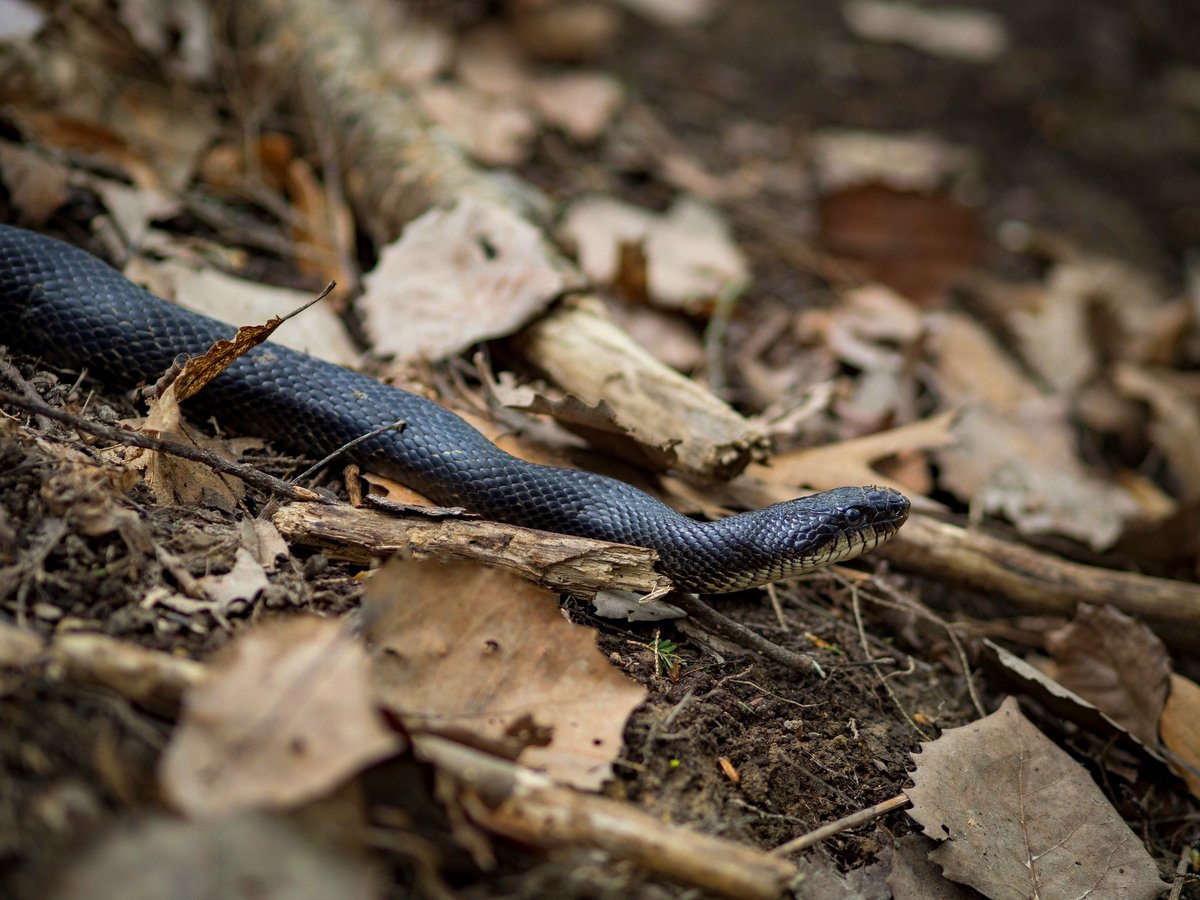Shades of Black and Gray: The bewildering systematics and semantics of Black Ratsnakes*
“So, Mark…” wrote Edie, the newsletter editor. “Could you write about Black Ratsnakes for the next issue?”
I remembered seeing this species, years ago, at the Lindsay-Parsons Biodiversity Preserve – a shiny black six-foot beauty wrapped around a beam of an abandoned outbuilding.
“Heck, yeah!” I replied. I went to two libraries and dug into Google Scholar in search of cool facts.
Black Ratsnakes occupy various habitats, wherever they can find both underground hibernacula and sunny spots for basking. Most often, they winter alone, but sometimes several share the same den. They even occasionally share dens with rattlesnakes or copperheads, sometimes in large numbers. When threatened, they sometimes coil and shake their tails, somewhat like rattlesnakes. Adult Black Ratsnakes can climb straight up rough-trunked trees and, with more difficulty, can ascend smooth trees too. They feed primarily on rodents, but also on birds and their eggs.
Cool facts indeed, widely and deservedly celebrated. But the recent technical literature reveals a deeper story, a tangled hidden tale that shook up my understanding of systematics, semantics, and what it means to be a Black Ratsnake.
It’s complicated, but I think it’s worth trying to explain.
The Black Ratsnake is a cauldron of bubbling taxonomic dispute. So far in this millennium, it’s already been reclassified and renamed at least four times, and split from one to three species. Controversy has continued to burn hot among leading herpetologists about nomenclature and the validity of the split, leading to confusion and even vitriol spilling over into the scientific literature.
The Black Ratsnake, formerly known as Elaphe obsoleta, was reassigned in 2005 to the genus Pantherophis. In 2008, some scientists placed it in the genus Scotophis, but since then the consensus has consolidated again around Pantherophis.
Since 2001, Dr. Frank Burbrink and colleagues have argued based on mitochondrial gene sequencing that the Black Ratsnake is actually three species. Using the new genus name, we have:
- Pantherophis quadrivittatus (Eastern Ratsnake) in the Atlantic coastal plain;
- P. alleghaniensis (Gray Ratsnake) roughly between the Appalachian Mountains and the Mississippi River; and
- P. obsoletus (Western Ratsnake) west of the Mississippi to Oklahoma and most of Texas.
(After the split, the present-day quadrivittatus was first known as alleghaniensis, and the present-day alleghaniensis first known as spiloides. The current, corrected renaming as of 2021 is no longer controversial among scientists, though it did lead to unseemly snippiness in the scientific journals as it was being resolved. The species names can still be very confusing if you’re a curious layperson like me, as many otherwise credible online sources still haven’t caught up.)

Gray Ratsnake (In the Finger Lakes region, adult Gray Ratsnakes are usually almost black in color) Photo: Chris Ray
The ratsnake of our Finger Lakes region is P. alleghaniensis. We call it the Gray Ratsnake because in most of its range, adults are gray. The only problem is that in our area and throughout the northern part of its range, P. alleghaniensis turns black as an adult.
So with the split, our ratsnakes are Gray Ratsnakes—but aren’t actually gray.
Our ratsnakes are black—but are no longer formally called Black Ratsnakes.
Indeed, after the split, the name Black Ratsnake doesn’t apply to anyone anymore, except in casual conversation, where it is still arguably the clearest, most accessible term – as long as the snakes are actually black. (What’s more, P. quadrivittatus are yellow or even bright orange as adults. They are informally called Yellow Ratsnakes.)
Opponents of the split point out that there is extensive gene flow and intergradation among the three ostensible species across broad areas. Given this mixing, as well as the absence of geographic barriers creating isolation, these scientists argue that we should recognize the ratsnake taxa as subspecies rather than species. Following this reasoning returns us to the pre-2001 consensus of one ratsnake species from the Atlantic to east-central Texas. The most proper scientific name would be Pantherophis obsoletus, and the best common name, given the color variation, would arguably be Eastern Ratsnake or Common Ratsnake, though surely Black Ratsnake would work too, if applicable colorwise.
Got all that? Me neither. My mind is still spinning, even after hours trying to make sense of it all.
So what is a Black Ratsnake?
Well, it’s a snake, or multiple snakes, or a phrase that applies to all or none of them. It’s a cool snake that eats rats. Except when it eats birds. It’s a cool, rat-eating, bird-eating, tree-climbing, den-sharing, controversy-stoking black snake. Unless it’s gray. Or orange.
* Or Black Rat Snakes, if you like. Here I follow the naming convention proposed in the dazzling 1997 book Snakes: The Evolution of Mystery in Nature, by Cornell professor Harry Greene. For groups of snake species, Greene concatenates short descriptors with the word “snake”–thus “ratsnake” and “coralsnake,” as with “rattlesnake.”

